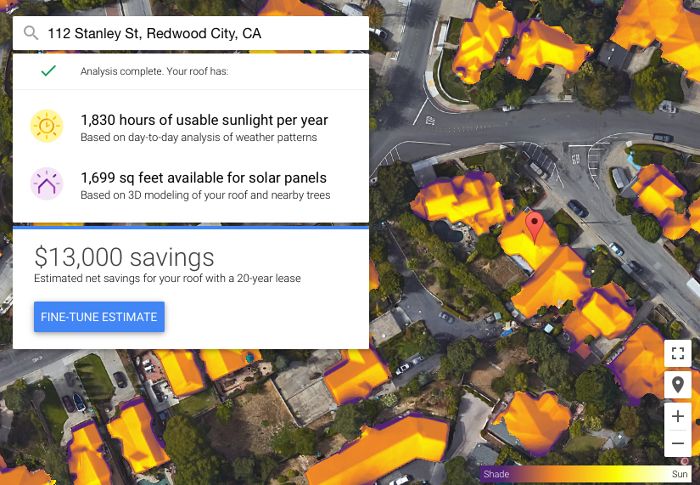
A pilot program just launched by Google gives homeowners in a few U.S. cities an estimate of how of their rooftops could be used for photovoltaic panels, and how much money they could save annually by installing them.
For now, Project Sunroof is available only in the San Francisco and Fresno, Calif., areas and around Boston, Mass. Plug in an address, and up pops an analysis based on weather patterns and 3D modeling of the roof and nearby trees.
Users can tell the program what an average monthly power bill looks like, and then toggle between lease, loan, and buy options to compare savings with each. The program also links users with solar installers in their area, according to an article in The Washington Post.
Helping allay fears about costs
The cost of solar panels has fallen dramatically in the last few years, but installing a residential system still isn’t cheap. So answering questions about costs is a major benefit of the project, The Post said. The software draws on information from banks and other financial institutions in predicting long-term savings, a Google public-affairs officer told the newspaper.
For example, at 112 Stanley St. in Redwood City, Calif., modeling based on an aerial photograph of the neighborhood predicts 1699 sq. ft. of rooftop could be used for solar panels, enough to support a solar array with a capacity of 4.5kw. The program compares 20-years savings when the panels are bought outright, leased from the installer, or bought with a loan. (In this instance, the program estimates savings of $23,000 when panels are bought outright, nearly twice as much as either of the other two options.)
Project Sunroof was developed by Google engineer Carl Elkin, who took advantage of a company program allowing employees to devote 20% of their work time to projects of their own choosing. The project could be expanded to other parts of the country in the months ahead.
“As a volunteer with the Boston-based solar program Solarize Massachusetts and a solar homeowner myself, I’ve always been surprised at how many people I encounter who think that ‘my roof isn’t sunny enough for solar,’ or ‘solar is just too expensive,'” Elkin writes in a post at Google’s Green Blog. “Certainly many of them are missing out on a chance to save money and be green.”
If you’re address isn’t currently in an area served by the program, you can leave it with Google and receive a note when your area is covered.
PVWatts Calculator is similar
Anyone considering the installation of a solar system can already get basic information about the solar potential of a building site with PVWatts Calculator, a program developed by the National Renewable Energy Laboratory.
It allows the entry of much more variables than does the Google program–such as the tilt of the roof and predicted loss of the system and whether racks will be fixed or tracking, for example–but it has less site-specific information.
It’s based on information for nearby weather stations, not a specific address, and without aerial photos to work with there’s no way to account for the size and orientation of the roof, or whether it’s affected by overhanging trees or nearby buildings.
Preliminary estimates that PVWatts produces would have to be fine-tuned with more sophisticated design tools. The same could be said of estimates produced by Project Sunroof.
Read more: http://www.greenbuildingadvisor.com/blogs/dept/green-building-news%2A#ixzz3jHckQkF5
Follow us: @gbadvisor on Twitter | GreenBuildingAdvisor on Facebook
Fine Homebuilding Recommended Products
Fine Homebuilding receives a commission for items purchased through links on this site, including Amazon Associates and other affiliate advertising programs.

Handy Heat Gun

Reliable Crimp Connectors

8067 All-Weather Flashing Tape

Homeowners in a few U.S. cities may now get an estimate of how much electricity rooftop solar panels would generate at their address. This is a screen shot for an address in Redwood City, Calif.






















